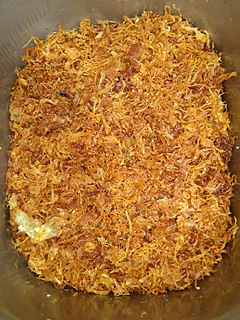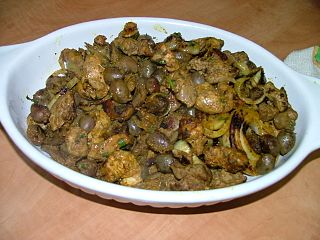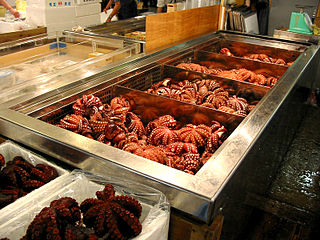
Korean cuisine has evolved through centuries of social and political change. Originating from ancient agricultural and nomadic traditions in Korea and southern Manchuria, Korean cuisine reflects a complex interaction of the natural environment and different cultural trends.

Swedish cuisine is the traditional food of Sweden. Due to Sweden's large north-to-south expanse, there are regional differences between the cuisine of North and South Sweden.

Teriyaki is a cooking technique used in Japanese cuisine in which foods are broiled or grilled with a glaze of soy sauce, mirin, and sugar.

Nokia is a town and a municipality on the banks of the Nokianvirta River in the region of Pirkanmaa, some 15 kilometres (9 mi) west of Tampere in Finland. The distance to Tampere Airport from Nokia is 16 kilometres (9.9 mi) using road connections when circling Lake Pyhäjärvi. Its neighboring municipalities are Hämeenkyrö, Pirkkala, Sastamala, Tampere, Vesilahti and Ylöjärvi. As of 31 December 2021 it has a population of 34,889 and it is one of the fastest-growing cities in the area; today, Nokia is the 33rd largest municipality of Finland by population, and the second largest municipality in Pirkanmaa after Tampere.

The cuisine of California reflects the diverse culture of California and is influenced largely by Hispanic America roots, alongside Eastern Asian and Oceanian influences and Western European influences, as well as the food trends and traditions of larger American cuisine.

The cuisine of the Southwestern United States is food styled after the rustic cooking of the Southwestern United States. It comprises a fusion of recipes for things that might have been eaten by Spanish colonial settlers, cowboys, Native Americans, and Mexicans throughout the post-Columbian era; there is, however, a great diversity in this kind of cuisine throughout the Southwestern states.

Al pastor, also known as tacos al pastor, is a taco made with spit-grilled pork. Cooking method is based on the lamb shawarma brought by Lebanese immigrants to Mexico, al pastor features a flavor palate that uses traditional Mexican marinade adobada. It is a popular street food that has spread to the United States. In some places of northern Mexico and coastal Mexico, such as in Baja California, Mexico, it is known as taco de trompo or taco de adobada. A similar dish from Puebla that uses a combination of middle eastern spices and indigenous central Mexican ingredients is called tacos árabes.

Peanut sauce, satay sauce, bumbu kacang, sambal kacang, or pecel is an Indonesian sauce made from ground roasted or fried peanuts, widely used in cuisines worldwide.

This is a listing of regional variations on the hot dog. Different areas of the world have local variations on the type of meat used, condiments, and means of preparation, which are listed below.

Fried onions are slices of onions that are either pan fried (sautéed) or deep fried — and consumed as a popular snack food, garnish, or vegetable accompaniment to various recipes.
Restaurants fall into several industry classifications, based upon menu style, preparation methods and pricing, as well as the means by which the food is served to the customer.

The cuisine of New Jersey is derived from the state's long immigrant history and its close proximity to both New York City and Philadelphia. Due to its geographical location, New Jersey can generally be divided by New York City cuisine in the northern and central parts of the state and Philadelphia cuisine in the southern parts. Restaurants in the state often make use of locally grown ingredients such as asparagus, blueberries, cranberries, tomatoes, corn, and peaches. New Jersey is home to approximately 525 diners, the most of any state. Various foods invented in the state, such as the pork roll, and salt water taffy, remain popular there today.

Jerusalem mixed grill is a grilled meat dish considered a specialty of Jerusalem. It consists of chicken hearts, spleens and liver mixed with bits of lamb cooked on a flat grill, seasoned with onion, garlic, black pepper, cumin, turmeric, olive oil and coriander.

Batak cuisine is the cuisine and cooking traditions of Batak ethnic groups, predominantly found in Northern Sumatra region, Indonesia. Batak cuisine is part of Indonesian cuisine, and compared to other Sumatran cuisine traditions, it is more indigenously preserved. One characteristic of Batak cuisine is its preference to andaliman as the main spice. That is why andaliman in Indonesia sometimes dubbed as "Batak pepper".

People of some cultures eat octopus. The arms and sometimes other body parts are prepared in various ways, often varying by species and/or geography.

Tchaka or Chaka is a Haitian stew made from hominy, beans, pumpkin (joumou), and meat. It is used as an offering to the loa in Haitian Vodou. The nutritious soup is also associated with festivities and family time.















